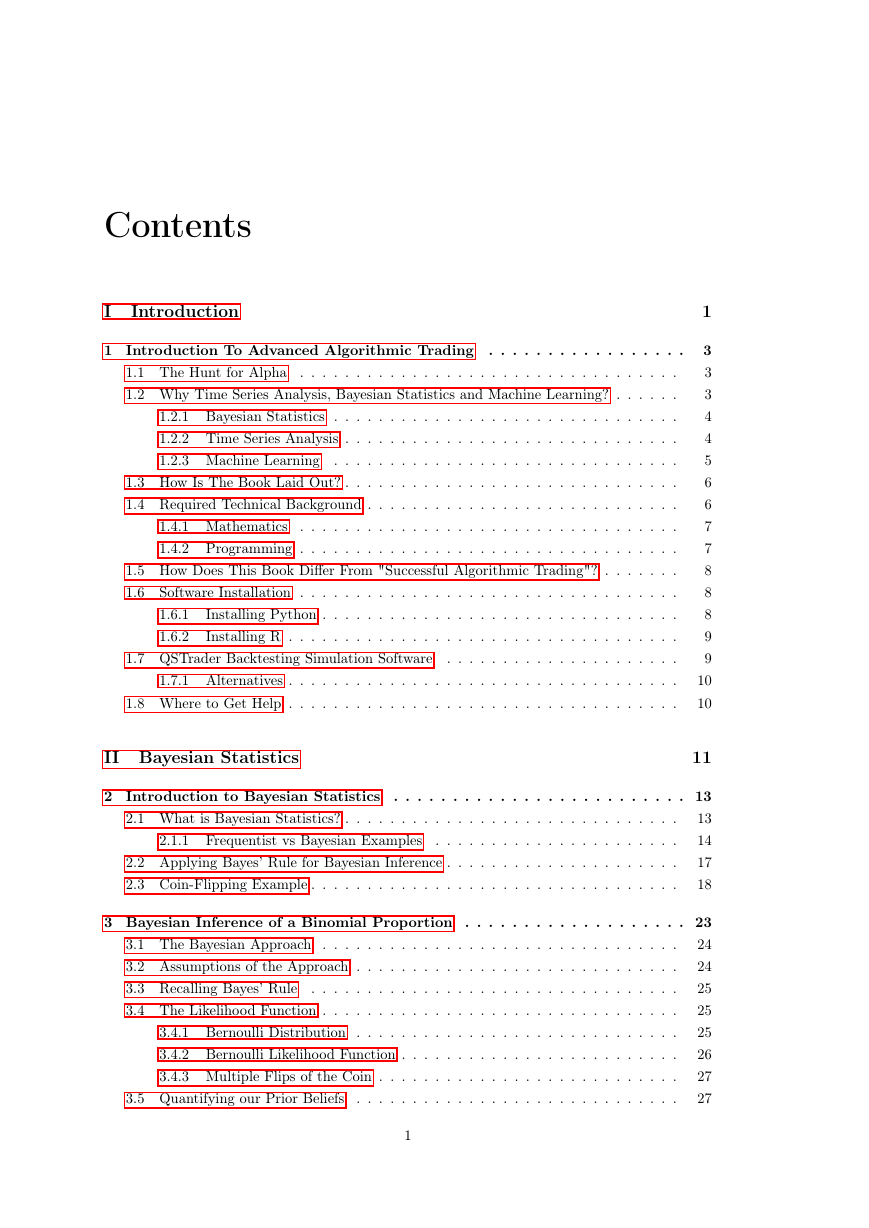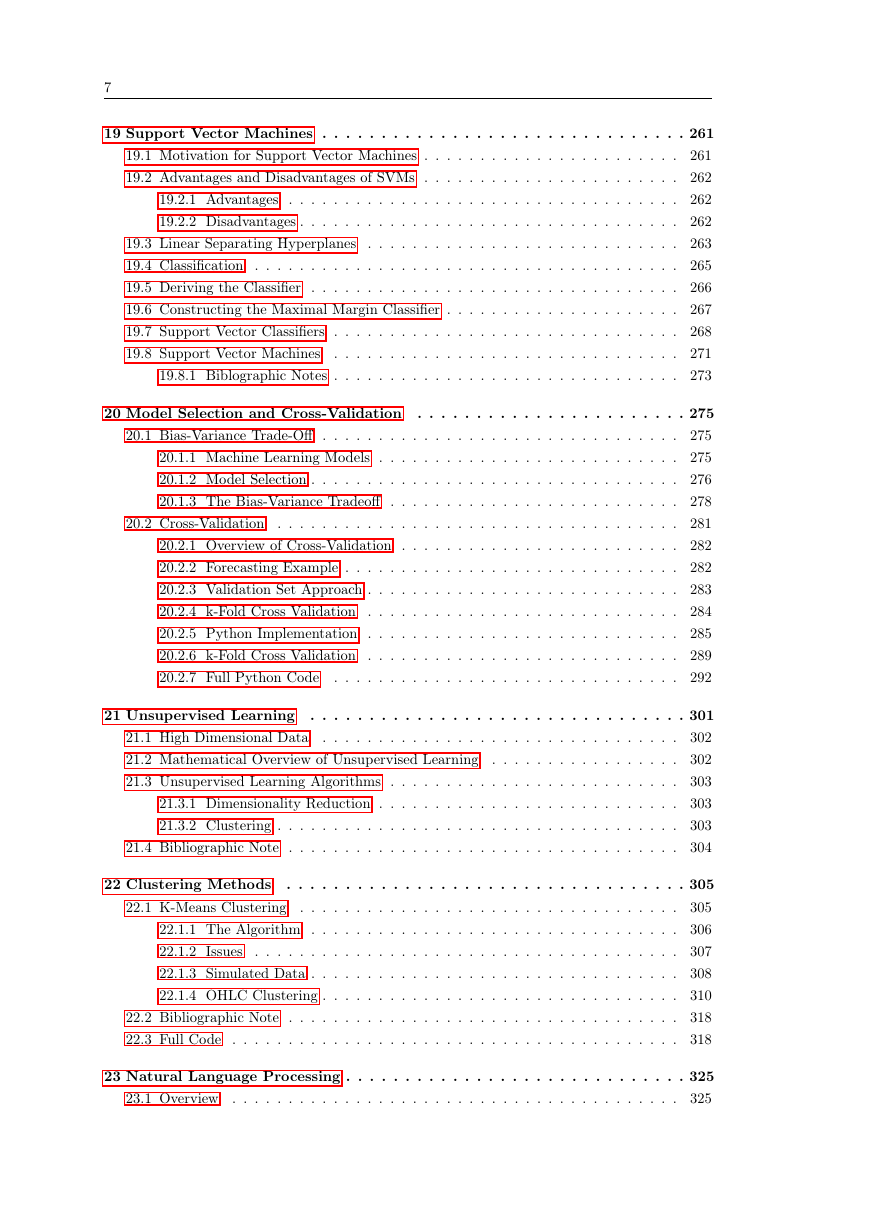I Introduction
Introduction To Advanced Algorithmic Trading
The Hunt for Alpha
Why Time Series Analysis, Bayesian Statistics and Machine Learning?
Bayesian Statistics
Time Series Analysis
Machine Learning
How Is The Book Laid Out?
Required Technical Background
Mathematics
Programming
How Does This Book Differ From "Successful Algorithmic Trading"?
Software Installation
Installing Python
Installing R
QSTrader Backtesting Simulation Software
Alternatives
Where to Get Help
II Bayesian Statistics
Introduction to Bayesian Statistics
What is Bayesian Statistics?
Frequentist vs Bayesian Examples
Applying Bayes' Rule for Bayesian Inference
Coin-Flipping Example
Bayesian Inference of a Binomial Proportion
The Bayesian Approach
Assumptions of the Approach
Recalling Bayes' Rule
The Likelihood Function
Bernoulli Distribution
Bernoulli Likelihood Function
Multiple Flips of the Coin
Quantifying our Prior Beliefs
Beta Distribution
Why Is A Beta Prior Conjugate to the Bernoulli Likelihood?
Multiple Ways to Specify a Beta Prior
Using Bayes' Rule to Calculate a Posterior
Markov Chain Monte Carlo
Bayesian Inference Goals
Why Markov Chain Monte Carlo?
Markov Chain Monte Carlo Algorithms
The Metropolis Algorithm
Introducing PyMC3
Inferring a Binomial Proportion with Markov Chain Monte Carlo
Inferring a Binonial Proportion with Conjugate Priors Recap
Inferring a Binomial Proportion with PyMC3
Bibliographic Note
Bayesian Linear Regression
Frequentist Linear Regression
Bayesian Linear Regression
Bayesian Linear Regression with PyMC3
What are Generalised Linear Models?
Simulating Data and Fitting the Model with PyMC3
Bibliographic Note
Full Code
Bayesian Stochastic Volatility Model
Stochastic Volatility
Bayesian Stochastic Volatility
PyMC3 Implementation
Obtaining the Price History
Model Specification in PyMC3
Fitting the Model with NUTS
Full Code
III Time Series Analysis
Introduction to Time Series Analysis
What is Time Series Analysis?
How Can We Apply Time Series Analysis in Quantitative Finance?
Time Series Analysis Software
Time Series Analysis Roadmap
How Does This Relate to Other Statistical Tools?
Serial Correlation
Expectation, Variance and Covariance
Example: Sample Covariance in R
Correlation
Example: Sample Correlation in R
Stationarity in Time Series
Serial Correlation
The Correlogram
Example 1 - Fixed Linear Trend
Example 2 - Repeated Sequence
Next Steps
Random Walks and White Noise Models
Time Series Modelling Process
Backward Shift and Difference Operators
White Noise
Second-Order Properties
Correlogram
Random Walk
Second-Order Properties
Correlogram
Fitting Random Walk Models to Financial Data
Autoregressive Moving Average Models
How Will We Proceed?
Strictly Stationary
Akaike Information Criterion
Autoregressive (AR) Models of order p
Rationale
Stationarity for Autoregressive Processes
Second Order Properties
Simulations and Correlograms
Financial Data
Moving Average (MA) Models of order q
Rationale
Definition
Second Order Properties
Simulations and Correlograms
Financial Data
Next Steps
Autogressive Moving Average (ARMA) Models of order p, q
Bayesian Information Criterion
Ljung-Box Test
Rationale
Definition
Simulations and Correlograms
Choosing the Best ARMA(p,q) Model
Financial Data
Next Steps
Autoregressive Integrated Moving Average and Conditional Heteroskedastic Models
Quick Recap
Autoregressive Integrated Moving Average (ARIMA) Models of order p, d, q
Rationale
Definitions
Simulation, Correlogram and Model Fitting
Financial Data and Prediction
Next Steps
Volatility
Conditional Heteroskedasticity
Autoregressive Conditional Heteroskedastic Models
ARCH Definition
Why Does This Model Volatility?
When Is It Appropriate To Apply ARCH(1)?
ARCH(p) Models
Generalised Autoregressive Conditional Heteroskedastic Models
GARCH Definition
Simulations, Correlograms and Model Fittings
Financial Data
Next Steps
Cointegrated Time Series
Mean Reversion Trading Strategies
Cointegration
Unit Root Tests
Augmented Dickey-Fuller Test
Phillips-Perron Test
Phillips-Ouliaris Test
Difficulties with Unit Root Tests
Simulated Cointegrated Time Series with R
Cointegrated Augmented Dickey Fuller Test
CADF on Simulated Data
CADF on Financial Data
EWA and EWC
RDS-A and RDS-B
Full Code
Johansen Test
Johansen Test on Simulated Data
Johansen Test on Financial Data
Full Code
State Space Models and the Kalman Filter
Linear State-Space Model
The Kalman Filter
A Bayesian Approach
Prediction
Dynamic Hedge Ratio Between ETF Pairs Using the Kalman Filter
Linear Regression via the Kalman Filter
Applying the Kalman Filter to a Pair of ETFs
TLT and ETF
Scatterplot of ETF Prices
Time-Varying Slope and Intercept
Next Steps
Bibliographic Note
Full Code
Hidden Markov Models
Markov Models
Markov Model Mathematical Specification
Hidden Markov Models
Hidden Markov Model Mathematical Specification
Filtering of Hidden Markov Models
Regime Detection with Hidden Markov Models
Market Regimes
Simulated Data
Financial Data
Next Steps
Bibliographic Note
Full Code
IV Statistical Machine Learning
Introduction to Machine Learning
What is Machine Learning?
Machine Learning Domains
Supervised Learning
Unsupervised Learning
Reinforcement Learning
Machine Learning Techniques
Linear Regression
Linear Classification
Tree-Based Methods
Support Vector Machines
Artificial Neural Networks and Deep Learning
Bayesian Networks
Clustering
Dimensionality Reduction
Machine Learning Applications
Forecasting and Prediction
Natural Language Processing
Factor Models
Image Classification
Model Accuracy
Parametric and Non-Parametric Models
Statistical Framework for Machine Learning Domains
Supervised Learning
Mathematical Framework
Classification
Regression
Financial Example
Training
Linear Regression
Linear Regression
Probabilistic Interpretation
Basis Function Expansion
Maximum Likelihood Estimation
Likelihood and Negative Log Likelihood
Ordinary Least Squares
Simulated Data Example with Scikit-Learn
Full Code
Bibliographic Note
Tree-Based Methods
Decision Trees - Mathematical Overview
Decision Trees for Regression
Creating a Regression Tree and Making Predictions
Pruning The Tree
Decision Trees for Classification
Classification Error Rate/Hit Rate
Gini Index
Cross-Entropy/Deviance
Advantages and Disadvantages of Decision Trees
Advantages
Disadvantages
Ensemble Methods
The Bootstrap
Bootstrap Aggregation
Random Forests
Boosting
Python Scikit-Learn Implementation
Bibliographic Note
Full Code
Support Vector Machines
Motivation for Support Vector Machines
Advantages and Disadvantages of SVMs
Advantages
Disadvantages
Linear Separating Hyperplanes
Classification
Deriving the Classifier
Constructing the Maximal Margin Classifier
Support Vector Classifiers
Support Vector Machines
Biblographic Notes
Model Selection and Cross-Validation
Bias-Variance Trade-Off
Machine Learning Models
Model Selection
The Bias-Variance Tradeoff
Cross-Validation
Overview of Cross-Validation
Forecasting Example
Validation Set Approach
k-Fold Cross Validation
Python Implementation
k-Fold Cross Validation
Full Python Code
Unsupervised Learning
High Dimensional Data
Mathematical Overview of Unsupervised Learning
Unsupervised Learning Algorithms
Dimensionality Reduction
Clustering
Bibliographic Note
Clustering Methods
K-Means Clustering
The Algorithm
Issues
Simulated Data
OHLC Clustering
Bibliographic Note
Full Code
Natural Language Processing
Overview
Supervised Document Classification
Preparing a Dataset for Classification
Vectorisation
Term-Frequency Inverse Document-Frequency
Training the Support Vector Machine
Performance Metrics
Full Code
V Quantitative Trading Techniques
Introduction to QSTrader
Motivation for QSTrader
Design Considerations
Installation
Introductory Portfolio Strategies
Motivation
The Trading Strategies
Data
Python QSTrader Implementation
MonthlyLiquidateRebalanceStrategy
LiquidateRebalancePositionSizer
Backtest Interface
Strategy Results
Transaction Costs
US Equities/Bonds 60/40 ETF Portfolio
"Strategic" Weight ETF Portfolio
Equal Weight ETF Portfolio
Full Code
ARIMA+GARCH Trading Strategy on Stock Market Indexes Using R
Strategy Overview
Strategy Implementation
Strategy Results
Full Code
Cointegration-Based Pairs Trading using QSTrader
The Hypothesis
Cointegration Tests in R
The Trading Strategy
Data
Python QSTrader Implementation
Strategy Results
Transaction Costs
Tearsheet
Full Code
Kalman Filter-Based Pairs Trading using QSTrader
The Trading Strategy
Data
Python QSTrader Implementation
Strategy Results
Next Steps
Full Code
Supervised Learning for Intraday Returns Prediction using QSTrader
Prediction Goals with Machine Learning
Class Imbalance
Building a Prediction Model on Historical Data
QSTrader Strategy Object
QSTrader Backtest Script
Results
Next Steps
Full Code
Sentiment Analysis via Sentdex Vendor Sentiment Data with QSTrader
Sentiment Analysis
Sentdex API and Sample File
The Trading Strategy
Data
Python Implementation
Sentiment Handling with QSTrader
Sentiment Analysis Strategy Code
Strategy Results
Transaction Costs
Sentiment on S&P500 Tech Stocks
Sentiment on S&P500 Energy Stocks
Sentiment on S&P500 Defence Stocks
Full Code
Market Regime Detection with Hidden Markov Models using QSTrader
Regime Detection with Hidden Markov Models
The Trading Strategy
Data
Python Implementation
Returns Calculation with QSTrader
Regime Detection Implementation
Strategy Results
Transaction Costs
No Regime Detection Filter
HMM Regime Detection Filter
Full Code
Strategy Decay
Calculating the Annualised Rolling Sharpe Ratio
Python QSTrader Implementation
Strategy Results
Kalman Filter Pairs Trade
Aluminum Smelting Cointegration Strategy
Sentdex Sentiment Analysis Strategy
















 2023年江西萍乡中考道德与法治真题及答案.doc
2023年江西萍乡中考道德与法治真题及答案.doc 2012年重庆南川中考生物真题及答案.doc
2012年重庆南川中考生物真题及答案.doc 2013年江西师范大学地理学综合及文艺理论基础考研真题.doc
2013年江西师范大学地理学综合及文艺理论基础考研真题.doc 2020年四川甘孜小升初语文真题及答案I卷.doc
2020年四川甘孜小升初语文真题及答案I卷.doc 2020年注册岩土工程师专业基础考试真题及答案.doc
2020年注册岩土工程师专业基础考试真题及答案.doc 2023-2024学年福建省厦门市九年级上学期数学月考试题及答案.doc
2023-2024学年福建省厦门市九年级上学期数学月考试题及答案.doc 2021-2022学年辽宁省沈阳市大东区九年级上学期语文期末试题及答案.doc
2021-2022学年辽宁省沈阳市大东区九年级上学期语文期末试题及答案.doc 2022-2023学年北京东城区初三第一学期物理期末试卷及答案.doc
2022-2023学年北京东城区初三第一学期物理期末试卷及答案.doc 2018上半年江西教师资格初中地理学科知识与教学能力真题及答案.doc
2018上半年江西教师资格初中地理学科知识与教学能力真题及答案.doc 2012年河北国家公务员申论考试真题及答案-省级.doc
2012年河北国家公务员申论考试真题及答案-省级.doc 2020-2021学年江苏省扬州市江都区邵樊片九年级上学期数学第一次质量检测试题及答案.doc
2020-2021学年江苏省扬州市江都区邵樊片九年级上学期数学第一次质量检测试题及答案.doc 2022下半年黑龙江教师资格证中学综合素质真题及答案.doc
2022下半年黑龙江教师资格证中学综合素质真题及答案.doc